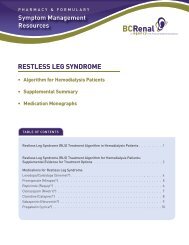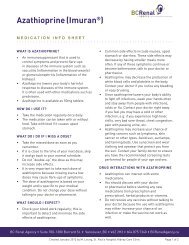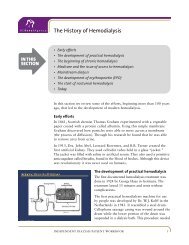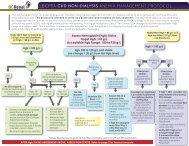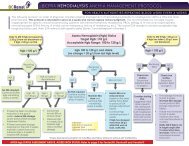Create successful ePaper yourself
Turn your PDF publications into a flip-book with our unique Google optimized e-Paper software.
V A S C U L A R A C C E S S F O R H E M O D I A L Y S I SBleeding Fistula or Graft:Emergency MeasuresIt is very rare for your fistula or graft to bleed after you leave the dialysis unit.For some people the chances are a little higher and the bleeding may be moreserious. If your health care team has identified that you may be one of thosepeople, this brochure tells you what to do. If you still have questions afterreading this, talk to your doctor or other member of your health care team.What might make a person more likelyto bleed excessively from their fistulaor graft?You are at higher likelihood to bleedexcessively from your fistula or graft if:1. An area on your fistula or graft:• is not healing• is infected• is bulging and is noticeably increasingin size• feels more pulsatile or firmer• has a very thin and shiny skin.2. Your venous pressures are high.3. Your INR (bleeding time ratio) is higherthan 2.If you have any of these, please let yourdialysis nurse know.If I am at risk for excessively bleedingfrom my fistula or graft, what suppliesshould I keep on hand?Supplies that you should keep on hand inyour emergency kit include:• 16 gauze pads, 4" x 4"• 2 gauze pads, 2" x 2"• 1 adhesive dressing or tape• 4 pairs of gloves (unsterile)• blood pressure cuffWhat should I do if there is excessivebleeding from my fistula or graft afterI leave the dialysis unit?1. Call for help from anyone who is at homewith you.2. Call 911 or have the person with you call911. You will need emergency attentioneven if the bleeding stops.3. Using gauze from your emergency kit, putpressure on the spot that is bleeding withthe tips of your fingers and press veryfirmly into your arm at that spot. If youdo not have gauze handy, use an absorbentcloth, tissue or paper towel.1 of Two
E M E R G E N C YM E A S U R E SGauze(Use TWOfingers)Needle holes into fistula/graft4. If this does not stop the bleeding, keepholding pressure over the hole and at thesame time press hard on the arterial endof your fistula or graft (if available, havea companion help you). If you have beenidentified at risk for bleeding and do notknow where the arterial end of your fistulaor graft is, please ask your nurse to showyou where to hold.5. If you are still not able to control thebleeding, place the blood pressure cufffrom your emergency kit around yourupper arm and inflate the cuff until theneedle is at 200. Keep the needle at 200 bysqueezing the bulb every few minutes. If youhave someone with you, ask them to help.The information in this pamphlet is providedfor educational and information purposes,and to support discussion with your healthcare team about your medical condition andtreatment. It does not constitute medicaladvice and should not substitute advice givenby your physician or other qualified healthcare professional.This brochure can be downloaded from the <strong>BC</strong><strong>Renal</strong> <strong>Agency</strong> website: www.bcrenalagency.ca6. Get to the emergency departmentimmediately.Important Phone NumbersKidney Doctor ______________________________________________________________________________________________Vascular Surgeon _______________________________________________________________________________________Dialysis Unit __________________________________________________________________________________________________Kidney Clinic __________________________________________________________________________________________________Vascular Access Clinic _____________________________________________________________________________This brochure is based on a similar pamphlet developed by VancouverIsland Health Authority, with appreciation.2 of Two




